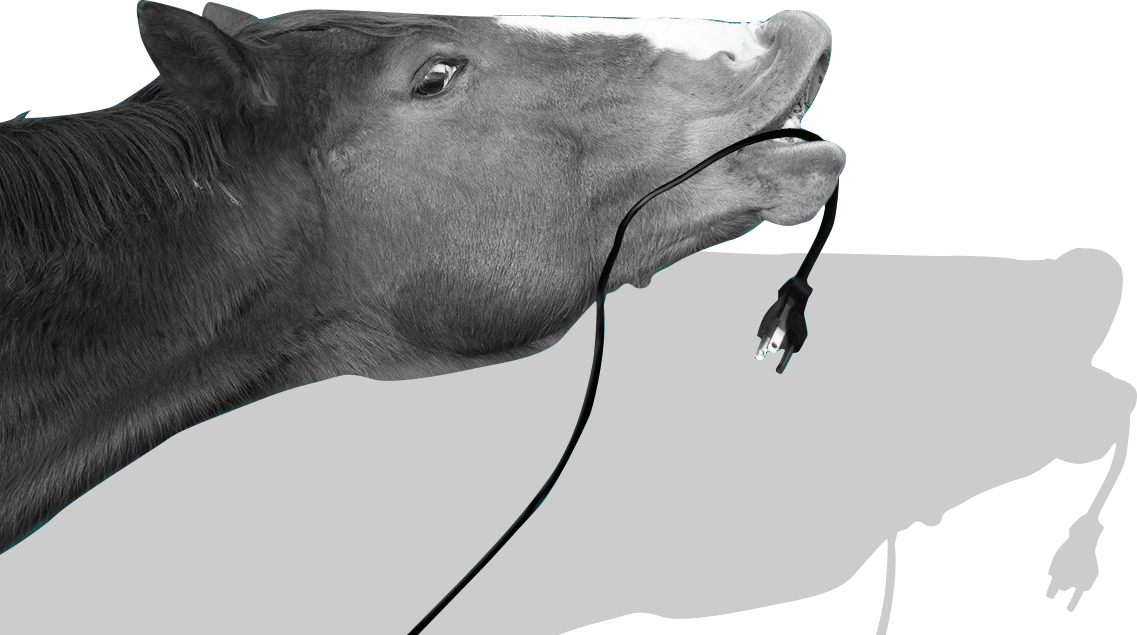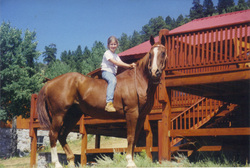Keeping your horse straight and moving forward is one of the most important parts of a good ride, whether you are in the arena or out on the trail. But its not as easy as it sounds… Many horses have habits of dropping their shoulder and cutting turns, getting “stuck” at the gate, or hugging the fence and rubbing a rider’s leg. This can be frustrating and annoying – possibly even dangerous if the behaviors continue to escalate. So what is the best way to correct these behaviors? How can you ride the horse in a way that keeps him straight? This week’s video is going to answer those questions.
I also listed the main points below the video as an additional reminder and reference.
To sum up my main points from the video – here is what you want to do on a horse that has issues steering and staying straight:
1. Always look where you are going. Find something very specific to look at if you are having trouble at a certain point or in a particular turn.
2. Use your seat and leg to go forward – this is very important – adding impulsion and forward drive will correct more issues than just steering with the reins.
3. When you do use your rein, use an opening rein instead of pulling straight back.
4. Feel the horse under you and correct the problem when it is just starting – a small movement off course means a small correction.
Did you like this video? Have any additional suggestions for hard-to-steer horses? Leave a comment!














28 Responses
Thank you, thank you, thank you!!!
Very informative video, so clearly explained how I wish we had all started off with such clearly explained instruction, the bad habits our horses have are mostly man made!
So helpful Callie. Thank you. I often ride a super school cob named Oliver, who likes to wander and determine his own direction! My first ride was a disaster but I researched and understood that my aids had been unclear and I had allowed Oliver to decide who was in control! I approached my second ride with confidence and after only a minute Oliver seemed to say ‘OK, so now she knows what she’s doing!’. I have discovered he is very sensitive to my aids and whilst he has a lively personality, he is a delight to ride! I am learning so much from your videos and love the passion you have for your horses.
Great job, Yvonne!
Nice analogy; the hands being puppet strings to the shoulders!
Can relate to all of that!
My instructor always tells me to use the outside rein, along with the inside leg, to keep my school horse close to the rail.
Thanks for another great video.
Great video! And i needed to listen to this one cause i have exact the same issue with my horse. He goes slow and sometimes stops and i can’t even move him no matter what i try. The instructor sais he doesn’t doing it with me. So i will try this tricks tomorrow and hope i can handle this much. Thank you so much Callie for all your time and awesome videos 🙂
I am so excited for tomorrow class 🙂
Hug
Karina
Hi Callie,
I loved your technique of inserting the clip of Ace demonstrating the problem while ridden by your student and then you demonstrating the way to correct it. I also love the written summary points! Puppet string analogy is very helpful, too. Great, easy to understand, concise – thanks for another wonderful video! Happy Independence day weekend! Margaret
Thank You very much, Callie. Not only is the video extremely helpful in how to correct these problems, but it is also a boost to my confidence knowing that I am not the only one who has had these problems. Now I have the knowledge to improve my riding. Thank you!
Glad you enjoyed it, George!
Thank you Callie!!!! Boy has taken to cutting one corner in particular and weaving his way down the arena…your explanation points and puppetry reference brings it all together. Cheers, brilliant instruction…L
Both of my horses were used as lesson horses for the last eight years and they have developed all of these habits. Thank you for this video. It’s exactly what I needed to keep them moving straight.
These were very helpful tips, especially the tips on how to manage the reins. My horse tends to hug the rail and I eventually figured out that I should ride inside a little. Is there any correction/punishment that needs to be done if the horse rides too close to the rail and the rider’s leg ends up hitting the rail? I got a painful bruise when that happened once and I have to admit, I was a little mad, but I’m guessing it wasn’t the horse’s fault but mine.
Hi Evelyn,
You are correct, it is rarely the horse’s fault and the horse isn’t typically “trying” to rub you on the rail. Most of the time it happens beccause the horse is getting crooked and not going straight with enough energy. Try riding more forward and if the problem and habit persists, keep your horse five feet or more from the rail so it gives you more time to get him going straight again if he starts heading for the rail.
Thank you for the great video. I echo others’ sentiments that the puppet string analogy is helpful.
I thought this video might include help with horses that balk. My horse will stop in random spots and just refuse to move. I’ve tried waiting him out, turning him to try to move in a different direction, using my seat and reigns lifted toward his ears to encourage impulsion, and finally a crop. He knows what he’s doing and what he should be doing. Do you have any suggestions?
This is very helpful. Now, how do I get my horse to do that long, flowing hunter stride at the 3 gaits?
Hi Lynda,
That is an involved question, and a good one for another video, or possibly a series of videos. Generally you have to have rythym and relaxation in the gaits, then you need to practice bending the horse, and encouraging the hind legs to step under and carry the weight of the body. This is where you can start to really feel that long, even, balanced movement. Of course, some horses have it naturally and others will take a lot more work and development physically to improve their movement.
Puppet strings….BRILLIANT analogy! Thank you, Callie!
Thanks. After riding a very responsive horse many times, I’m now riding a lesson horse who goes toward the gate, turns in, and gets wiggly just as you are describing. Although my instructor gave me good advice, I didn’t understand why he was doing this, until I watched your video. I’m sure I’m guilty of not keeping my eyes on where we are supposed to be going. I was worried that I would develop bad hand habits by using the opening rein, since the responsive horse had required only tiny motions of closing the hand, and very gentle calf pressure, to respond. Now I realize that the rider has to adapt the aids to the particular horse, and that one can expect a lesson horse to be insensitive. More complications for the beginner – but a valuable lesson on evading a horse’s evasions. 😉 Thanks for offering your expertise to us!
Glad it was helpful, Lorima!
Great video Callie, very helpful. I’m an absolute novice and the horses I’m riding are not true lesson horses. They were donated to our equine therapy program and as such are not very soft at all. Our program manager is training them diligently but they’ve had a long time to develop bad habits. I feel like these tips will give me better control over my horse. Thanks!
Very nice blog. Lots of good info. Keep up the good work.
That was so helpful Callie. I’ve just started riding a horse I bought for me and my two daughters to share, 7 years ago, but way back then I realised she was too sensitive for me and I wasn’t a good enough rider. Now I have to ride her as the kids are not around so much and I am trying hard to improve my riding. I love the style you use to teach…..kind , calm and sympathetic to both the horse and the rider. My horse does like to drop her shoulder when i try to do flat work and I’ve always got muddled about which hand should go up etc. Now I’ve watched your video, it makes complete sense and I’m so glad I have found you!!! I think my horse is going to be pleased too! Thank you.
Hi Karen, you want to lift the rein that is on the inside of the bend! Make sure to stay open through the shoulder as you open the rein 🙂
-Julia Burdy, CRK Training Community Manager
Thank you for this video. My boy had a habit of dropping his shoulder in on turns on his off side, but after watching your video, I am better at recognising the start of it, and was astonished how responsive he was to the lifted inside rein, open outer one and very light pressure on the inside leg. He immediately straightened himself up. Other riders said ” how did you do that?” After making the correction several times yesterday, today I only needed to do it once, and he didn’t regress at all. We were both very pleased with ourselves. So thank you very much.
Hello Callie,
I am now riding Diamond, my teacher’s horse, who has been brought out of semi-retirement, for me to ride and continue my lessons on, until we find that horse of my own, since Mocha is no longer available. Diamond was bred and trained by my instructor, and is very sensitive to the aids. However, after having been on ‘vacation’ all summer, she’s a bit of a butterball, and a bit stiff, so this first month is getting to know her, and to ease her back into shape. So far, she’s a bit hollow going to the right, and also falls in to the right at the corners, and at one corner in particular (I’ve only ridden her three times so far, and am only doing walk to rising trot transitions before we go on to sitting trot to canter transitions, as she gets into better condition). On my most recent ride, I tried squaring the corners (going to the right) and also used inside leg to outside rein, envisioning her neck ‘filling’ the outside rein, and things were much improved. What an affirmation to watch this particular video, which I just discovered! Thank you, as always for your wonderful, insightful instruction.
Glad to hear that Diamond has improved! This is also a great example of a time to use some in hand exercises if your trainer will allow 🙂
-Julia, CRK Training Community Manager
Very good idea! I’ll be seeing my trainer Thursday, and I’m sure she’ll be all for it. She really likes CRK, and her teaching principles and methods align with CRK’s.